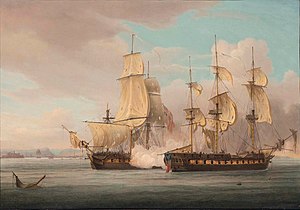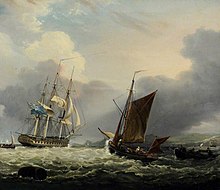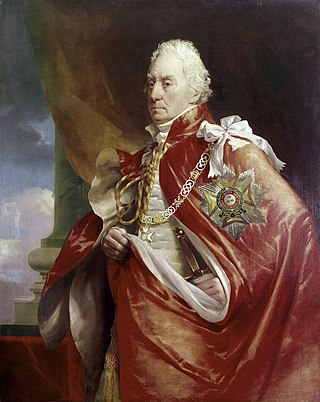
George Keith Elphinstone, 1st Viscount Keith was a Royal Navy officer, politician and peer who served in the French Revolutionary and Napoleonic Wars.

Admiral of the Red James Saumarez, 1st Baron de Saumarez, GCB was an admiral of the British Royal Navy, known for his victory at the Second Battle of Algeciras.

Sir Charles Brisbane KCB was an officer of the Royal Navy who served during the American War of Independence, and with distinction under Lords Hood and Nelson.

HMS Sirius was a 36-gun fifth-rate frigate of the Royal Navy. Between 1797 and 1805, the Sirius was engaged in maintaining the blockade of Napoleonic Europe. She was lost in 1810 when her crew scuttled her after she grounded during the Battle of Grand Port.

HMS Berwick was a 74-gun Elizabeth-class third rate of the Royal Navy, launched at Portsmouth Dockyard on 18 April 1775, to a design by Sir Thomas Slade. She fought the French at the Battle of Ushant (1778) and the Dutch at the Battle of Dogger Bank (1781). The French captured her in the action of 8 March 1795 during the French Revolutionary Wars and she served with them with some success then and at the start of the Napoleonic Wars until the British recaptured her at the Battle of Trafalgar. Berwick sank shortly thereafter in a storm.

HMS Hannibal was a 74-gun third-rate ship of the line of the Royal Navy, launched on 15 April 1786, named after the Carthaginian general Hannibal. She is best known for having taken part in the Algeciras Campaign, and for having run aground during the First Battle of Algeciras on 5 July 1801, which resulted in her capture. She then served in the French Navy until she was broken up in 1824.
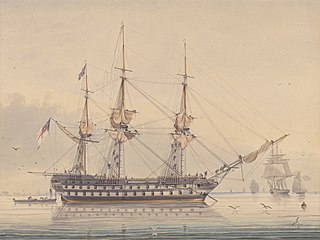
HMS Donegal was launched in 1794 as Barra, a Téméraire class 74-gun ship of the line of the French Navy. She was renamed Pégase in October 1795, and Hoche in December 1797. The British Royal Navy captured her at the Battle of Tory Island on 12 October 1798 and recommissioned her as HMS Donegal.
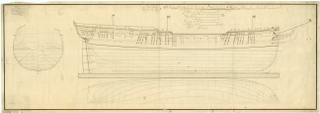
HMS Cerberus was a 32-gun fifth-rate frigate of the Royal Navy. She served in the French Revolutionary and the Napoleonic Wars in the Channel, the Mediterranean, the Adriatic, and even briefly in the Baltic against the Russians. She participated in one boat action that won for her crew a clasp to the Naval General Service Medal (NGSM). She also captured many privateers and merchant vessels. Her biggest battle was the Battle of Lissa, which won for her crew another clasp to the NGSM. She was sold in 1814.

Cléopâtre was a 32-gun Vénus class frigate of the French Navy. She was designed by Jacques-Noël Sané, and had a coppered hull. She was launched in 1781, and the British captured her in 1793. She then served the Royal Navy as HMS Oiseau until she was broken up in 1816.

HMS Druid was a 32-gun Hermione-class fifth-rate frigate of the British Royal Navy, launched in 1783 at Bristol. She served in the French Revolutionary Wars and the Napoleonic Wars, capturing numerous small prizes. One of her commanders, Captain Philip Broke, described Druid as a "point of honour ship", i.e., a ship too large to run but too small to fight. He and his biographer's view was that it was a disgrace to use a ship like her as a warship. She was broken up in 1813, after a thirty-year career.

HMS Cleopatra was a 32-gun Amazon-class fifth-rate frigate of the Royal Navy. She had a long career, seeing service during the Fourth Anglo-Dutch War, and the French Revolutionary and Napoleonic Wars. During the latter wars she fought two notable engagements with larger French opponents. In the first engagement she was forced to surrender, but succeeded in damaging the French ship so badly that she was captured several days later, while Cleopatra was retaken. In the second she forced the surrender of a 40-gun frigate. After serving under several notable commanders she was broken up towards the end of the Napoleonic Wars.

Hugh Downman was an officer of the Royal Navy who saw service during the American War of Independence and the French Revolutionary and Napoleonic Wars, eventually rising to the rank of admiral.

The action of 20 October 1793 was a minor naval engagement of the French Revolutionary Wars fought off Cape Barfleur on the French coast of the English Channel. The early months of the war, which had begun in February, had seen a number of French frigates raiding British merchant shipping in the Channel, and HMS Crescent under Captain James Saumarez was deployed to watch the port of Cherbourg-en-Cotentin with the aim of disrupting the operations of the French frigates Réunion and Sémillante that were based in the harbour. On 20 October, Saumarez was waiting off Cape Barfleur for French movement when his lookout sighted Réunion and the cutter Espérance approaching from open water.
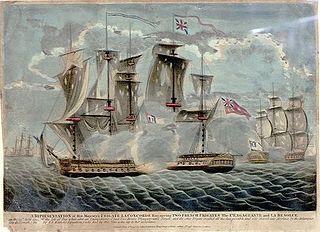
Concorde was a 32-gun frigate of the French Navy, lead ship of her class. Built in Rochefort in 1777, she entered service with the French early in the American War of Independence and was soon in action, capturing HMS Minerva in the West Indies. She survived almost until near the end of the war when HMS Magnificent captured her in 1783. Not immediately brought into service due to the draw-down in the navy after the end of the war, Concorde underwent repairs and returned to active service with the outbreak of war with France in 1793 as the fifth-rate HMS Concorde.
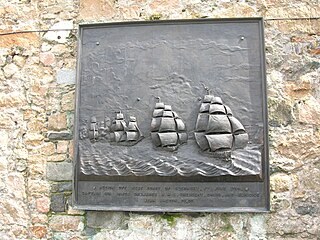
His Majesty's hired armed lugger Valiant served the Royal Navy on a contract from 5 May 1794 to 10 November 1801. She was of 109 90⁄94 tons (bm), and was armed with eleven 3-pounder guns.

La Réunion was a 36-gun French warship launched in 1786. During the French Revolutionary War she was stationed at Cherbourg and was successfully employed harassing British merchant shipping in the English Channel until the British captured her off the Cotentin Peninsula during the action of 20 October 1793. Renamed HMS Reunion, she served for three years in the Royal Navy helping to counter the threat from the new Batavian Navy, before she was wrecked in the Thames Estuary in December 1796.

The capitulation of Saldanha Bay was the surrender to the British of a Batavian expeditionary force sent to recapture the Dutch Cape Colony in 1796. In 1795, early in the War of the First Coalition, French troops overran the Dutch Republic which then became a French client state, the Batavian Republic. Great Britain was concerned by the threat that the Cape Colony posed to its trade routes to British India. It therefore sent an expeditionary force that landed at Simon's Town in June 1795 and forced the surrender of the colony in a short campaign. British Vice-Admiral Sir George Elphinstone, then reinforced the garrison and stationed a naval squadron at the Cape Colony to protect it.

The invasion of the Cape Colony, also known as the Battle of Muizenberg, was a British military expedition launched in 1795 against the Dutch Cape Colony at the Cape of Good Hope. The Dutch colony at the Cape, established and controlled by the United East India Company in the seventeenth century, was at the time the only viable South African port for ships making the journey from Europe to the European colonies in the East Indies. It therefore held vital strategic importance, although it was otherwise economically insignificant. In the winter of 1794, during the French Revolutionary Wars, French troops entered the Dutch Republic, which was reformed into the Batavian Republic.

Essex was launched in 1780 as an East Indiaman. She made six voyages for the British East India Company (EIC). On her first voyage she was present at an inconclusive battle with the French, and later at a second inconclusive engagement with a French frigate. In 1798 she was sold to be hulked or broken up.
HM hired armed lugger Cockchafer was a hired armed vessel, possibly actually a shallop, that served the Royal Navy from 6 May 1794 to her loss on 2 November 1801.
